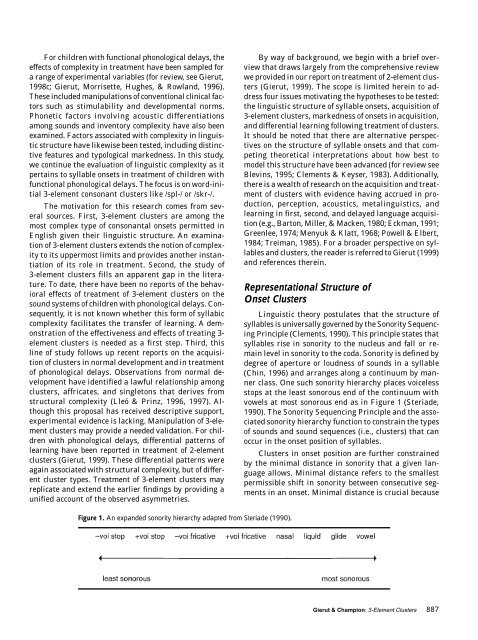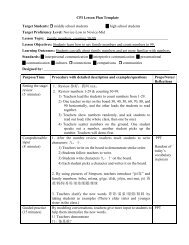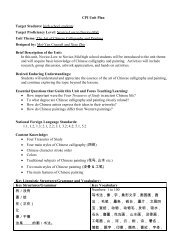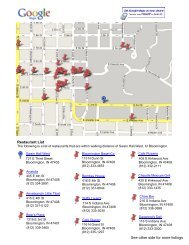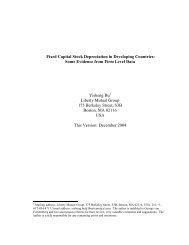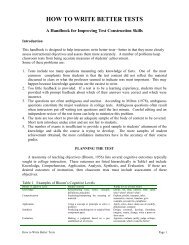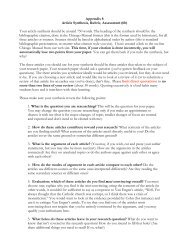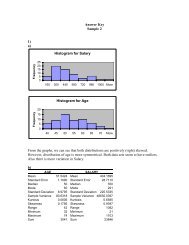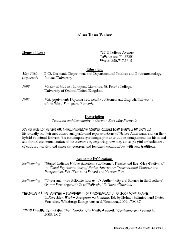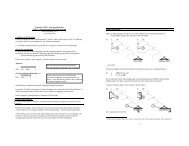Syllable Onsets II: Three-Element Clusters in Phonological Treatment
Syllable Onsets II: Three-Element Clusters in Phonological Treatment
Syllable Onsets II: Three-Element Clusters in Phonological Treatment
Create successful ePaper yourself
Turn your PDF publications into a flip-book with our unique Google optimized e-Paper software.
For children with functional phonological delays, the<br />
effects of complexity <strong>in</strong> treatment have been sampled for<br />
a range of experimental variables (for review, see Gierut,<br />
1998c; Gierut, Morrisette, Hughes, & Rowland, 1996).<br />
These <strong>in</strong>cluded manipulations of conventional cl<strong>in</strong>ical factors<br />
such as stimulability and developmental norms.<br />
Phonetic factors <strong>in</strong>volv<strong>in</strong>g acoustic differentiations<br />
among sounds and <strong>in</strong>ventory complexity have also been<br />
exam<strong>in</strong>ed. Factors associated with complexity <strong>in</strong> l<strong>in</strong>guistic<br />
structure have likewise been tested, <strong>in</strong>clud<strong>in</strong>g dist<strong>in</strong>ctive<br />
features and typological markedness. In this study,<br />
we cont<strong>in</strong>ue the evaluation of l<strong>in</strong>guistic complexity as it<br />
perta<strong>in</strong>s to syllable onsets <strong>in</strong> treatment of children with<br />
functional phonological delays. The focus is on word-<strong>in</strong>itial<br />
3-element consonant clusters like /spl-/ or /skr-/.<br />
The motivation for this research comes from several<br />
sources. First, 3-element clusters are among the<br />
most complex type of consonantal onsets permitted <strong>in</strong><br />
English given their l<strong>in</strong>guistic structure. An exam<strong>in</strong>ation<br />
of 3-element clusters extends the notion of complexity<br />
to its uppermost limits and provides another <strong>in</strong>stantiation<br />
of its role <strong>in</strong> treatment. Second, the study of<br />
3-element clusters fills an apparent gap <strong>in</strong> the literature.<br />
To date, there have been no reports of the behavioral<br />
effects of treatment of 3-element clusters on the<br />
sound systems of children with phonological delays. Consequently,<br />
it is not known whether this form of syllabic<br />
complexity facilitates the transfer of learn<strong>in</strong>g. A demonstration<br />
of the effectiveness and effects of treat<strong>in</strong>g 3-<br />
element clusters is needed as a first step. Third, this<br />
l<strong>in</strong>e of study follows up recent reports on the acquisition<br />
of clusters <strong>in</strong> normal development and <strong>in</strong> treatment<br />
of phonological delays. Observations from normal development<br />
have identified a lawful relationship among<br />
clusters, affricates, and s<strong>in</strong>gletons that derives from<br />
structural complexity (Lleó & Pr<strong>in</strong>z, 1996, 1997). Although<br />
this proposal has received descriptive support,<br />
experimental evidence is lack<strong>in</strong>g. Manipulation of 3-element<br />
clusters may provide a needed validation. For children<br />
with phonological delays, differential patterns of<br />
learn<strong>in</strong>g have been reported <strong>in</strong> treatment of 2-element<br />
clusters (Gierut, 1999). These differential patterns were<br />
aga<strong>in</strong> associated with structural complexity, but of different<br />
cluster types. <strong>Treatment</strong> of 3-element clusters may<br />
replicate and extend the earlier f<strong>in</strong>d<strong>in</strong>gs by provid<strong>in</strong>g a<br />
unified account of the observed asymmetries.<br />
By way of background, we beg<strong>in</strong> with a brief overview<br />
that draws largely from the comprehensive review<br />
we provided <strong>in</strong> our report on treatment of 2-element clusters<br />
(Gierut, 1999). The scope is limited here<strong>in</strong> to address<br />
four issues motivat<strong>in</strong>g the hypotheses to be tested:<br />
the l<strong>in</strong>guistic structure of syllable onsets, acquisition of<br />
3-element clusters, markedness of onsets <strong>in</strong> acquisition,<br />
and differential learn<strong>in</strong>g follow<strong>in</strong>g treatment of clusters.<br />
It should be noted that there are alternative perspectives<br />
on the structure of syllable onsets and that compet<strong>in</strong>g<br />
theoretical <strong>in</strong>terpretations about how best to<br />
model this structure have been advanced (for review see<br />
Blev<strong>in</strong>s, 1995; Clements & Keyser, 1983). Additionally,<br />
there is a wealth of research on the acquisition and treatment<br />
of clusters with evidence hav<strong>in</strong>g accrued <strong>in</strong> production,<br />
perception, acoustics, metal<strong>in</strong>guistics, and<br />
learn<strong>in</strong>g <strong>in</strong> first, second, and delayed language acquisition<br />
(e.g., Barton, Miller, & Macken, 1980; Eckman, 1991;<br />
Greenlee, 1974; Menyuk & Klatt, 1968; Powell & Elbert,<br />
1984; Treiman, 1985). For a broader perspective on syllables<br />
and clusters, the reader is referred to Gierut (1999)<br />
and references there<strong>in</strong>.<br />
Representational Structure of<br />
Onset <strong>Clusters</strong><br />
L<strong>in</strong>guistic theory postulates that the structure of<br />
syllables is universally governed by the Sonority Sequenc<strong>in</strong>g<br />
Pr<strong>in</strong>ciple (Clements, 1990). This pr<strong>in</strong>ciple states that<br />
syllables rise <strong>in</strong> sonority to the nucleus and fall or rema<strong>in</strong><br />
level <strong>in</strong> sonority to the coda. Sonority is def<strong>in</strong>ed by<br />
degree of aperture or loudness of sounds <strong>in</strong> a syllable<br />
(Ch<strong>in</strong>, 1996) and arranges along a cont<strong>in</strong>uum by manner<br />
class. One such sonority hierarchy places voiceless<br />
stops at the least sonorous end of the cont<strong>in</strong>uum with<br />
vowels at most sonorous end as <strong>in</strong> Figure 1 (Steriade,<br />
1990). The Sonority Sequenc<strong>in</strong>g Pr<strong>in</strong>ciple and the associated<br />
sonority hierarchy function to constra<strong>in</strong> the types<br />
of sounds and sound sequences (i.e., clusters) that can<br />
occur <strong>in</strong> the onset position of syllables.<br />
<strong>Clusters</strong> <strong>in</strong> onset position are further constra<strong>in</strong>ed<br />
by the m<strong>in</strong>imal distance <strong>in</strong> sonority that a given language<br />
allows. M<strong>in</strong>imal distance refers to the smallest<br />
permissible shift <strong>in</strong> sonority between consecutive segments<br />
<strong>in</strong> an onset. M<strong>in</strong>imal distance is crucial because<br />
Figure 1. An expanded sonority hierarchy adapted from Steriade (1990).<br />
Gierut & Champion: 3-<strong>Element</strong> <strong>Clusters</strong> 887


